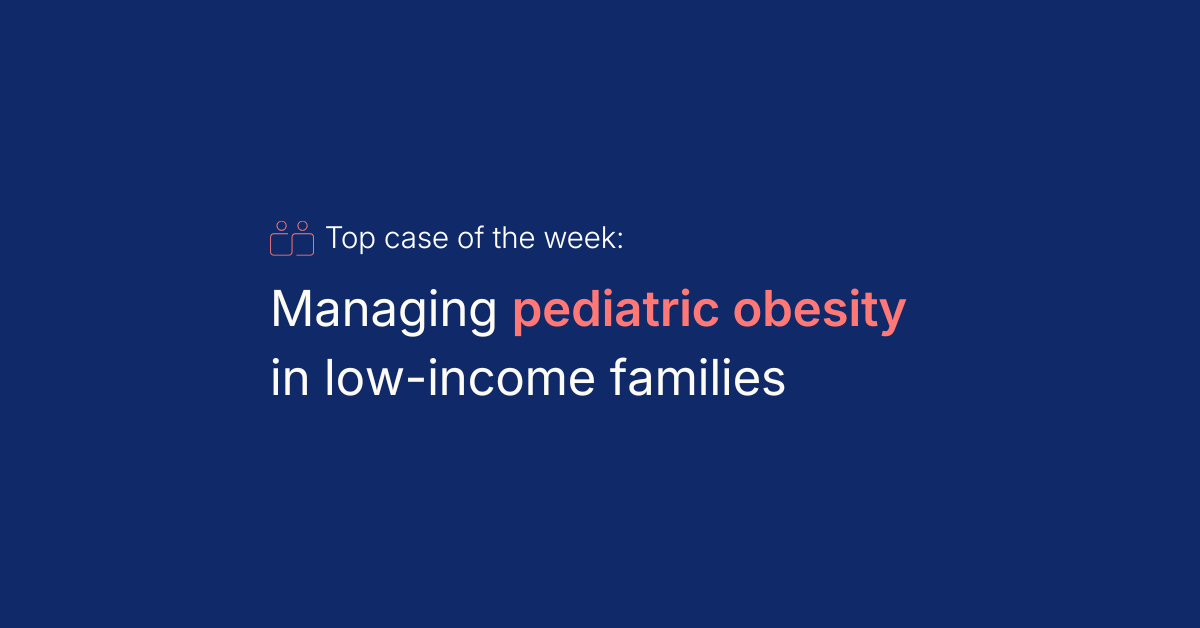
Strategies for managing pediatric obesity in low-income families

Pediatric obesity in low-income families presents a complex challenge, where clinical guidance must be balanced with the realities of limited resources.
Read how practitioners are approaching pediatric obesity on Healthcasts. Then log in or sign up to see the Consensus.
Post:
Pediatric obesity remains a growing public health challenge, especially in underserved communities where financial and geographic access to structured exercise programs, unprocessed foods, and specialty care may be limited. Children in low-income households often face compounding barriers such as food deserts, safety concerns limiting outdoor activity, and inconsistent healthcare follow-up.
Recent approvals of pharmacologic agents like GLP-1 receptor agonists for adolescent obesity have raised questions about when and how to incorporate these therapies in challenging socioeconomic contexts.



 Questions for consult
Questions for consult
 Consults
Consults
Key takeaways for treating pediatric obesity in low-income families:
- Focus on family-based lifestyle changes
Small, consistent steps, like daily walks around the neighborhood, home exercises, and healthier meals, can make a big impact. - Tap community resources
School programs, local pantries, and YMCA activities can help overcome barriers to nutrition and getting enough exercise. - Consider medication selectively
GLP-1 agonists may be used when lifestyle changes aren’t enough, typically under a specialist's guidance.
Family Practice
"I try to see if there is any way to improve their nutrition and exercise first and foremost. If they do have limited access to fresh foods and physical activity, I would prescribe them a GLP-1. I much prefer this to bariatric surgery.
I've had schools provide nutritious lunches and snacks for those who cannot afford it, even in summer. I've also had patients take advantage of SNAP benefits."
Pediatrics
"Obesity management should be tailored to the family. For healthy changes to be made, whole lifestyle changes for the family need to be instituted. Finances are definitely an issue, but I council regarding easy ways to put fitness in that are not expensive that can be done in the home, or simply hiking or walking briskly. In addition, we talk about a healthy diet that can be achieved through whole grains, fruits, and good sources of protein, which are financially feasible.
Some of my patients are on GLP ones, but this is through endocrinology. There are minimal community resources at this point."
Family Practice
"My approach to pediatric childhood obesity is parent-focused. Parents have the responsibility to provide their children appropriate foods to the best of their abilities, monitoring number of calories in, and also making sure that they have appropriate exercise activities to burn calories in excess of those taken in.
I have limited experience with GOP use in adolescence and have reservations because of the lack of studies to support providers who prescribe these medications and there is also concern about cost of treatment. Community partnerships, including YMCA and athletic programs, are an excellent source of exercise for the children, and the more activities they participate in, the less time they will spend at home looking at the refrigerator. Ultimately, the responsibility is on the parent."
Pediatrics
"1. I find that having open conversations with patients and their families to reflect understanding that healthy lifestyle modifications are not easy puts them on the same page and makes the conversation feel less judgmental. I also provide guidance on the importance of taking small steps and maintaining consistency over longer periods, which can yield results that are sustainable, such as taking daily walks, making simple food substitutions, and finding enjoyable activities.
2. No, although I have found other providers who are more comfortable having the discussion about these options and prescribing them.
3. I have found that education and consistent follow-up have been most beneficial. Our system also has a clinic that focuses on pediatric obesity care, where we have seen good results for these patients."
Pediatrics
"Exercise outside can be difficult, especially if the child lives in an unsafe neighborhood. I suggest putting on music and dancing or watching some YouTube videos to dance along with such as Zumba. Eating healthy is expensive, but junk food has become increasingly expensive also. Have the child help pick out some healthy food they will agree to eat, or at least try.
I also like to make a game for the child where I draw a rainbow with 6 slots, one for each main color. If they eat or at least try something in that color, they can color in that part of the rainbow arch. If all gets colored in, they get the pot of gold or a prize that the parent has pre-negotiated and not a food reward. It has worked well except for the one kid who pointed out that Skittles would work for this, too! Community efforts are hard. I know people with bumper crops in their garden who will take the extra to their local pantry. We should encourage that."
To explore more peer insights on managing pediatric obesity in low-income families or contribute your opinion to the conversation, read the full case on Healthcasts.

